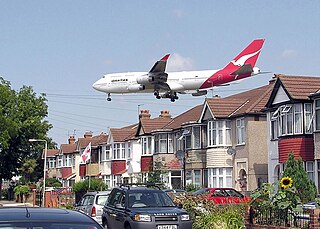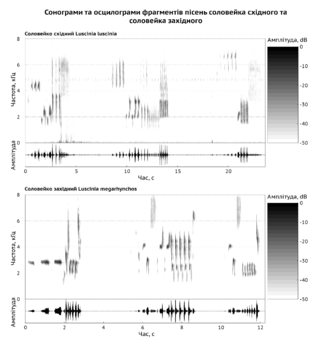
Ecology is the study of the relationships among living organisms, including humans, and their physical environment. Ecology considers organisms at the individual, population, community, ecosystem, and biosphere level. Ecology overlaps with the closely related sciences of biogeography, evolutionary biology, genetics, ethology, and natural history. Ecology is a branch of biology, and it is not synonymous with environmentalism.

Noise pollution, or sound pollution, is the propagation of noise or sound with ranging impacts on the activity of human or animal life, most of which are harmful to a degree. The source of outdoor noise worldwide is mainly caused by machines, transport and propagation systems. Poor urban planning may give rise to noise disintegration or pollution, side-by-side industrial and residential buildings can result in noise pollution in the residential areas. Some of the main sources of noise in residential areas include loud music, transportation, lawn care maintenance, construction, electrical generators, wind turbines, explosions and people.

In ecology, a niche is the match of a species to a specific environmental condition. It describes how an organism or population responds to the distribution of resources and competitors and how it in turn alters those same factors. "The type and number of variables comprising the dimensions of an environmental niche vary from one species to another [and] the relative importance of particular environmental variables for a species may vary according to the geographic and biotic contexts".

Bioacoustics is a cross-disciplinary science that combines biology and acoustics. Usually it refers to the investigation of sound production, dispersion and reception in animals. This involves neurophysiological and anatomical basis of sound production and detection, and relation of acoustic signals to the medium they disperse through. The findings provide clues about the evolution of acoustic mechanisms, and from that, the evolution of animals that employ them.
A soundscape is the acoustic environment as perceived by humans, in context. The term was originally coined by Michael Southworth, and popularised by R. Murray Schafer. There is a varied history of the use of soundscape depending on discipline, ranging from urban design to wildlife ecology to computer science. An important distinction is to separate soundscape from the broader acoustic environment. The acoustic environment is the combination of all the acoustic resources, natural and artificial, within a given area as modified by the environment. The International Organization for Standardization (ISO) standardized these definitions in 2014.

Niche construction is the process by which an organism alters its own local environment. These alterations can be a physical change to the organism’s environment or encompass when an organism actively moves from one habitat to another to experience a different environment. Examples of niche construction include the building of nests and burrows by animals, and the creation of shade, influencing of wind speed, and alternation of nutrient cycling by plants. Although these alterations are often beneficial to the constructor, they are not always.

An ecosystem engineer is any species that creates, significantly modifies, maintains or destroys a habitat. These organisms can have a large impact on species richness and landscape-level heterogeneity of an area. As a result, ecosystem engineers are important for maintaining the health and stability of the environment they are living in. Since all organisms impact the environment they live in one way or another, it has been proposed that the term "ecosystem engineers" be used only for keystone species whose behavior very strongly affects other organisms.

Charles Sutherland Elton was an English zoologist and animal ecologist. He is associated with the development of population and community ecology, including studies of invasive organisms.
Natural sounds are any sounds produced by non-human organisms as well as those generated by natural, non-biological sources within their normal soundscapes. It is a category whose definition is open for discussion. Natural sounds create an acoustic space.
Acoustic ecology, sometimes called ecoacoustics or soundscape studies, is a discipline studying the relationship, mediated through sound, between human beings and their environment. Acoustic ecology studies started in the late 1960s with R. Murray Schafer a musician, composer and former professor of communication studies at Simon Fraser University with the help of his team there as part of the World Soundscape Project. The original WSP team included Barry Truax and Hildegard Westerkamp, Bruce Davies and Peter Huse, among others. The first study produced by the WSP was titled The Vancouver Soundscape. This innovative study raised the interest of researchers and artists worldwide, creating enormous growth in the field of acoustic ecology. In 1993, the members of the by now large and active international acoustic ecology community formed the World Forum for Acoustic Ecology.

Bernard L. Krause is an American musician and soundscape ecologist. In 1968, he founded Wild Sanctuary, an organization dedicated to the recording and archiving of natural soundscapes. Krause is an author, a bio-acoustician, a speaker, and natural sound artist who coined the terms geophony, biophony, and anthropophony.
Ecology and evolutionary biology is an interdisciplinary field of study concerning interactions between organisms and their ever-changing environment, including perspectives from both evolutionary biology and ecology. This field of study includes topics such as the way organisms respond and evolve, as well as the relationships among animals, plants, and micro-organisms, when their habitats change. Ecology and evolutionary biology is a broad field of study that covers various ranges of ages and scales, which can also help us to comprehend human impacts on the global ecosystem and find measures to achieve more sustainable development.
The following outline is provided as an overview of and topical guide to ecology:
Sensory ecology is a relatively new field focusing on the information organisms obtain about their environment. It includes questions of what information is obtained, how it is obtained, and why the information is useful to the organism.
Biomusic is a form of experimental music which deals with sounds created or performed by non-humans. The definition is also sometimes extended to include sounds made by humans in a directly biological way. For instance, music that is created by the brain waves of the composer can also be called biomusic as can music created by the human body without the use of tools or instruments that are not part of the body.

Urban wildlife is wildlife that can live or thrive in urban/suburban environments or around densely populated human settlements such as townships.
An autonomous recording unit (ARU) is a self-contained audio recording device that is deployed in marine or terrestrial environments for bioacoustical monitoring. The unit is used in both marine and terrestrial environments to track the behavior of animals and monitor their ecosystems. On a terrestrial level, the ARU can detect noises coming from bird habitats and determine relative emotions that each bird conveys along with the population of the birds and the relative vulnerability of the ecosystem. The ARU can also be used to understand noises made by marine life to see how the animals' communication affects the operation of their ecosystem. When underwater, the ARU can track the sound that human made machines make and see the effect those sounds have on marine life ecosystems. Up to 44 work days can be saved through the utilization of ARU's, along with their ability to discover more species.
In ecology, species homogeneity is a lack of biodiversity. Species richness is the fundamental unit in which to assess the homogeneity of an environment. Therefore, any reduction in species richness, especially endemic species, could be argued as advocating the production of a homogeneous environment.
Road ecology is the study of the ecological effects of roads and highways. These effects may include local effects, such as on noise, water pollution, habitat destruction/disturbance and local air quality; and the wider environmental effects of transport such as habitat fragmentation, ecosystem degradation, and climate change from vehicle emissions.
Ecomusicology is an area of study that explores the relationships between music or sound, and the natural environment. It is a study which encompasses a variety of academic disciplines including musicology, biology, ecology and anthropology. Ecomusicology combines these disciplines to explore how sound is produced by natural environments and, more broadly how cultural values and concerns about nature are expressed through sonic mediums. Ecomusicology explores the ways that music is composed to replicate natural imagery, as well as how sounds produced within the natural environment are used within musical composition. Ecological studies of sounds produced by animals within their habitat are also considered to be part of the field of ecomusicology. In the 21st century, studies within the field the ecomusicology have also become increasingly interested in the sustainability of music production and performance.












